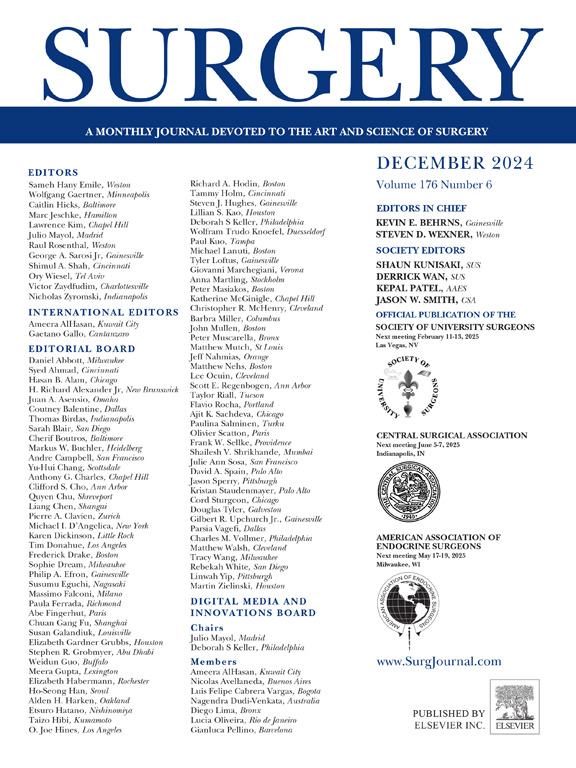邻里社会剥夺在转诊到肾移植过程中的重要性
IF 2.7
2区 医学
Q1 SURGERY
引用次数: 0
摘要
尽管已知社会剥夺对肾移植机会的影响,但没有工具可以量化使用社区水平的社会经济剥夺接受移植的可能性。方法选取2017年7月至2022年1月间接受肾移植评估的患者。使用DeGAUSS (Decentralized Geomarker Assessment for Multi-Site Studies)系统对患者的地址进行地理编码,并生成剥夺指数。创建了一个内部验证的预测评分,以量化患者转诊后未被列入候补名单或移植的风险。结果4852例转介肾移植患者中,3816例(78.6%)从未成功等待或移植。最高剥夺四分位数的患者(84.0%,n = 1,007/1,199)比最低剥夺四分位数的患者(74.3%,n = 893/1,202)更不可能等待或移植。男性、年龄较大、透析时间较长、剥夺程度较高的患者等待或移植的可能性较小(曲线下面积为71.2%)。基于比值比评分可以创建肾移植可及性预测评分,该评分为男性、剥夺指数≥46、年龄≥57、接受血液透析和透析时间≥24个月分配分数。评分≥4分有93.7%的人从未被列入候补名单或移植,并且在验证测试中以72%的灵敏度识别出最高风险。结论:利用转诊时已知的因素,我们创建了一个预测工具来评估谁不太可能成功接受肾移植。利用这一模型,中心可以制定有针对性的干预措施,从而增加肾脏移植的公平获取。本文章由计算机程序翻译,如有差异,请以英文原文为准。

Importance of social deprivation by neighborhood on the pathway from referral to kidney transplantation
Background
Despite the known impact of social deprivation on kidney transplant access, no instrument exists that quantifies the likelihood of receiving a transplant using neighborhood-level socioeconomic deprivation.
Methods
Patients referred for kidney transplant evaluation from July 2017 and January 2022 were evaluated. Patients' addresses were geocoded using the DeGAUSS (Decentralized Geomarker Assessment for Multi-Site Studies) system, and deprivation index was generated. An internally validated prediction score was created to quantify a patient's risk of not being waitlisted or transplanted after referral.
Results
Of the 4,852 patients referred for kidney transplant, 3,816 (78.6%) were never successfully waitlisted or transplanted. Patients from the highest deprivation quartile were less likely to be waitlisted or transplanted (84.0%, n = 1,007/1,199) than those from the lowest deprivation quartile (74.3%, n = 893/1,202). Patients who were male, older, spent more time on dialysis, and had higher deprivation levels were less likely to be waitlisted or transplanted (area under the curve 71.2%). Assigning scores based on odds ratios allowed creation of the Kidney Transplant Access Prediction score, which assigns points for male sex, deprivation index ≥46, age ≥57, being on hemodialysis, and spending ≥24 months on dialysis. A score ≥4 had a 93.7% rate of never being waitlisted or transplanted and identified those at highest risk with a 72% sensitivity on validation testing.
Conclusion
Using factors known at referral, we have created a prediction tool to evaluate who is less likely to successfully receive a kidney transplant. Using this model, centers can develop targeted interventions, which can increase equitable access to kidney transplantation.
求助全文
通过发布文献求助,成功后即可免费获取论文全文。
去求助
来源期刊

Surgery
医学-外科
CiteScore
5.40
自引率
5.30%
发文量
687
审稿时长
64 days
期刊介绍:
For 66 years, Surgery has published practical, authoritative information about procedures, clinical advances, and major trends shaping general surgery. Each issue features original scientific contributions and clinical reports. Peer-reviewed articles cover topics in oncology, trauma, gastrointestinal, vascular, and transplantation surgery. The journal also publishes papers from the meetings of its sponsoring societies, the Society of University Surgeons, the Central Surgical Association, and the American Association of Endocrine Surgeons.
 求助内容:
求助内容: 应助结果提醒方式:
应助结果提醒方式:


